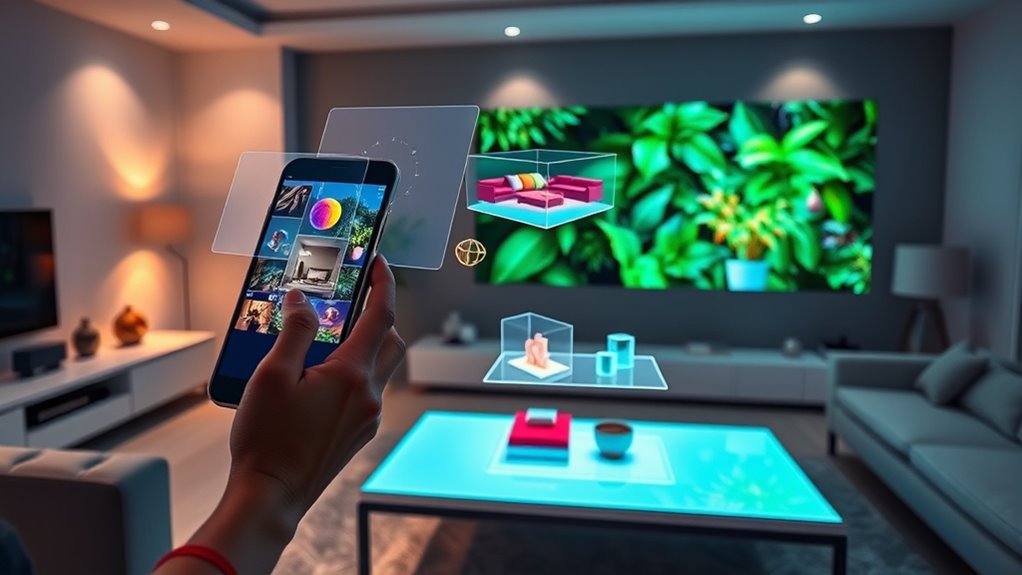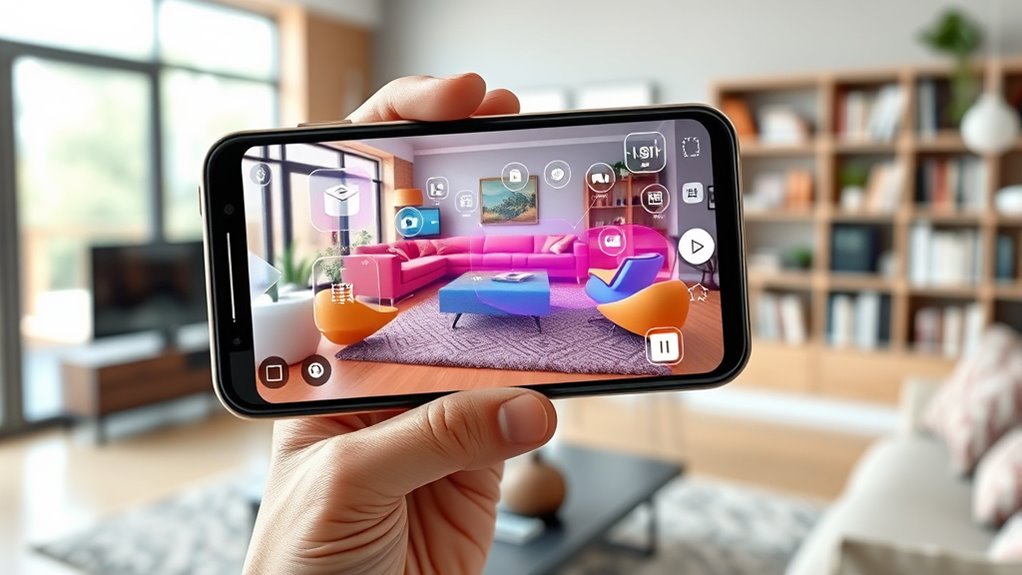Today, you can explore many augmented reality apps beyond gaming that enhance shopping, learning, navigation, and daily tasks. For example, AR apps let you virtually try on clothes, glasses, or makeup, making shopping easier and more fun. You can navigate new places with AR-guided directions, or learn by viewing detailed 3D models of machines or anatomy. These apps make everyday activities more interactive and convenient—if you stay tuned, you’ll discover even more ways AR can transform your routines.
Key Takeaways
- AR shopping apps allow virtual try-ons for clothing, glasses, and makeup without visiting stores.
- Navigation apps overlay real-time directions and labels onto your environment for easier wayfinding.
- Educational AR apps bring 3D models and immersive content to museums, classrooms, and training sessions.
- Maintenance and repair apps display detailed instructions and 3D models directly on physical objects.
- AR for interior design and furniture placement helps visualize decor in your actual space before purchasing.

Augmented Reality (AR) apps are transforming the way you interact with the digital and physical worlds by overlaying virtual objects onto your real-world environment. With AR, you can do more than just play games; you can experience practical and innovative solutions right from your smartphone or AR glasses. For instance, virtual try-ons have become a game-changer in retail, allowing you to see how clothes, glasses, or makeup look on you without stepping into a store. You simply point your camera at yourself or use your device to see a realistic preview of how products fit or appear. This not only saves time but also boosts confidence in your purchasing decisions. Whether you’re shopping for new sneakers or trying out a new hairstyle, virtual try-ons make the process interactive, fun, and convenient. Additionally, AR apps are increasingly incorporating hardware advancements, enhancing performance and realism across various applications. AR navigation takes your wayfinding to the next level by overlaying directional arrows and labels onto your real-world view. Instead of constantly glancing at a map or GPS screen, you get real-time guidance directly in your environment. As you walk through unfamiliar streets or large indoor spaces like malls or airports, AR navigation guides you seamlessly, showing you exactly where to turn or which corridor to follow. This intuitive guidance simplifies complex routes and helps you avoid confusion, making your journeys smoother and more efficient. Both virtual try-ons and AR navigation exemplify how AR apps are making everyday activities easier, more engaging, and less stressful. Beyond shopping and navigation, AR apps are also enhancing learning, maintenance, and entertainment. For example, you might use AR to see detailed 3D models of machinery or anatomy, aiding in repair or education. In museums or historical sites, AR brings exhibits to life, providing immersive stories and visuals that deepen your understanding. These apps are designed to be user-friendly, giving you immediate access to useful information without the need for bulky equipment or complicated setups. They adapt to your environment, making interactions more natural and engaging. As AR technology continues to evolve, you’ll find even more innovative ways to incorporate it into your daily routines, whether for work, leisure, or self-improvement. The possibilities are virtually endless, and the best part is, you don’t need specialized skills—just a compatible device and a curiosity to explore what AR can do for you.
Frequently Asked Questions
How Secure Are Augmented Reality Apps Regarding User Privacy?
When it comes to privacy concerns with augmented reality apps, you should be aware that they often collect significant data, like your location and device info. While some apps prioritize security, others may not have strong protections, risking your personal information. Always check app permissions and privacy policies before use. Staying cautious helps reduce risks linked to data collection and guarantees your privacy stays protected while enjoying AR experiences.
Can AR Apps Be Used Offline Without Internet Connectivity?
You can use some AR apps offline, but their functionality depends on how they’re designed. Offline functionality allows you to access certain features without internet, which can be handy in areas with poor connectivity. However, privacy concerns may arise if the app still collects data locally. Always check if the AR app offers offline mode and review its privacy policies to guarantee your data stays secure while enjoying offline features.
What ARe the Hardware Requirements for Running Advanced AR Apps?
Think of your device as a spaceship ready for launch—advanced AR apps demand specific hardware. You’ll need powerful processing power to handle real-time graphics, and wearable devices like AR glasses or headsets that support high-resolution displays. A fast processor, ample RAM, and a capable GPU are essential to keep the experience smooth. Without these, your AR journey might feel like a rocket stuck on the launchpad.
How Do AR Apps Integrate With Other Digital Platforms?
You can see how AR apps integrate with digital platforms through AR content creation and platform integration. They connect seamlessly with social media, e-commerce, and enterprise systems, allowing you to share immersive experiences or enhance workflows. By leveraging APIs and SDKs, you enable smooth data exchange and interaction, making AR a powerful tool across various platforms. This integration broadens AR’s functionality, helping you reach your audience more effectively and innovate your digital presence.
ARe There Any Age Restrictions for Using Specific AR Applications?
Did you know that many AR apps have age restrictions to guarantee safe use? These restrictions are often in place because of content or safety concerns, making parental guidance essential for younger users. You should always check the app’s guidelines before allowing children to use AR applications. Age restrictions help protect kids and provide a better experience, so staying informed and supervising their usage is key.
Conclusion
Now that you’ve explored these augmented reality apps, it’s clear they’re more than just a passing fad—they’re transforming how you see and interact with the world. Whether for learning, shopping, or practical tasks, AR is here to stay. Don’t wait for the dust to settle; jump in and make the most of these innovative tools. After all, the early bird catches the worm, so why not be among the first to embrace this exciting technology?









